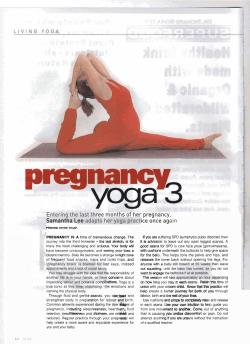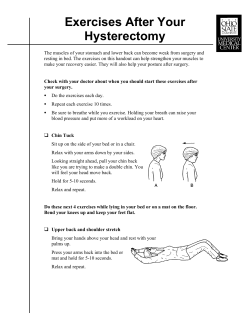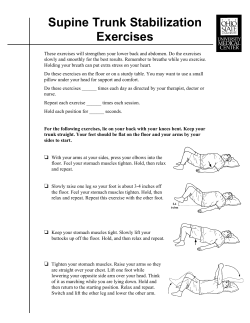
Acute Lower Back Pain ©iStockphoto.com
Acute Lower Back Pain ©iStockphoto.com Back pain is a common condition and in the UK, it affects 7 out of 10 people at some point in their lives. Back pain can be very uncomfortable, but it is not usually serious. Back pain can affect anyone, regardless of age, but it is more common in people who are between 35 and 55 years of age. In the majority of cases, the cause of back pain can be linked to the way that the bones, muscles and ligaments in the back work together. Lower back pain Lower back pain can come on suddenly or gradually and is sometimes the direct result of a fall or injury. The complex structure of your lower back means that even small amounts of strain to any part of the lumbar region (lower back) can cause a lot of pain and discomfort. Most cases of back pain will resolve and staying active and continuing with your usual activities will normally promote healing. Back pain will usually last from a few days to a few weeks. Pain that lasts longer usually clears up after about six weeks. However, in severe and persistent cases of back pain of over 6 weeks, it is important to seek medical advice so that a correct diagnosis can be reached and appropriate treatment given. Treatment for back pain will usually depend on the underlying cause of the condition. For example, pain that is caused by some types of arthritis may be treated using specific medicines. 2 Symptoms The symptoms of lower back pain can be described as a pain or ache anywhere on your back. If you experience back pain together with any of the following symptoms, visit your GP as soon as possible: • • • • • • • • • • Fever Weight loss Redness or swelling Unremitting back pain Pain traveling to the chest or higher in the back Pain down both of the legs and past the knees Recent trauma Loss of bladder or bowel control Difficulty passing urine Numbness around the genitals, buttocks or anus Ask your GP for advice if your back pain has developed gradually and has got increasingly worse over several days or weeks. Causes Most cases of lower back pain are known as non-specific because they are not caused by serious damage or disease, but by sprains, muscle strains, minor injuries or a pinched or irritated nerve. Back pain can also be triggered by everyday activities at home or work, and by poor posture. For example, back pain may be triggered by: • • • • • • Bending awkwardly Lifting, carrying, pushing or pulling incorrectly Poor posture when sitting or standing Twisting and overstretching Coughing and sneezing Muscle tension ©PhysioTools 3 Treating Acute Back Pain Most cases of acute back pain can be treated using self-help techniques. These are discussed below. Drug Treatment – Several medications can help with the symptoms of lower back pain. These include painkillers (such as paracetamol) and anti-inflammatories (such as ibuprofen). You should seek guidance from your pharmacist or GP when considering using anti-inflammatories, especially if there is a risk of stomach problems. There is much debate on the use of dietary supplements (e.g. glucosamine and chondroitin tablets, fish oils, etc). Although some people report beneficial effects from these treatments, they have yet to be satisfactorily proven in clinical trials. Compression packs - Either hot or cold compression packs helps reduce pain. Posture: Sitting Sit in a supportive, comfortable chair. Avoid low, soft chairs or sofas. Keep hips higher than knees. Your neck should be in a relaxed, upright position, not poking forward. If sitting at a desk, your elbows should be at desk height. Adjust your seat to allow your lower back to maintain its lumbar curve. You might like to use a rolled up towel in the small of your back. If you are at a desk, your chair should be pulled right underneath. Avoid twisting movements. The keyboard, mouse and telephone should be in easy reach. When driving on long journeys make sure that you take frequent breaks. Get out of the car and take a short walk. Try arching your back or bending down to touch your toes. 4 Remember, your spine likes movement. Try and change position every 20 – 30 minutes! There is no right or wrong position for sleeping. When lying down you should aim to keep the spinal curves in alignment. Exercise IIt is important to remain as physically active as possible. While bed rest may provide some temporary relief from your symptoms, prolonged bed rest will make your symptoms worse. Recommended exercises for back pain include walking and gentle stretching. Your back pain may be so severe that you need to have some time off work. However, if this is the case, you should aim to return to work as soon as possible. While you may not feel any immediate benefit, research has shown the people who continue to work during an episode of back pain recover more quickly than people who stay at home. REMEMBER! Most back pain DOES get better. It just takes a little time. The more you put the advice into practice, the better recovery you should make. Following are some exercises to get you going. If you find that any of these exercises increase your pain then STOP doing them immediately. If they help, try and do them twice a day. If you have any queries regarding this information or the exercises mentioned, please contact the Physiotherapy Department: Tel: 01342 414004. 5 Personal Exercise Program Lie on your back with your legs bent, knees and feet hip-distance apart. There should be a small gap under your lower back and your hip bones should be level. Gently pull your pelvic floor muscles up and in. It may help to imagine that you are trying to stop yourself from passing water mid-flow. ©PhysioTools Do not allow your back to flatten hard onto the floor. Hold this contraction with minimal effort. Remember to breathe throughout. Hold for 10 seconds. Relax for 10 seconds. Repeat 10 times. Lie with your knees bent and feet on the floor. Lift your knees towards your chest. Place your hands behind both knees and draw them towards your chest. Hold for 20 seconds. Repeat 3 times. ©PhysioTools 6 Lie on your back with your knees bent and feet and feet together. Slowly roll your knees from side to side keeping your upper trunk still. Repeat 10 times. ©PhysioTools In the crawling position: knees under hips and hands under shoulders. Arch your spine upwards while letting your head relax between your arms. Move slowly and do not strain the arched position. Hold this position for a few seconds then relax. ©PhysioTools Squeeze the buttocks and hollow the abdominal muscles to tuck the pelvis and flex the whole back up. Hold this position for few seconds then relax. Repeat 10 times. a ©PhysioTools 7 Please ask if you would like this leaflet in larger print or an alternative format. Physiotherapy Issue 1 – Ref. No. 0415 Approved by the Patient Information Group Print November 2012 – Review November 2015 www.qvh.nhs.uk
© Copyright 2024





















